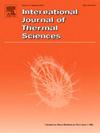Accurate prediction of the rheological behavior of MWCNT-Al2O3/water-ethylene glycol nanofluid with metaheuristic-optimized machine learning models
IF 4.9
2区 工程技术
Q1 ENGINEERING, MECHANICAL
International Journal of Thermal Sciences
Pub Date : 2025-01-13
DOI:10.1016/j.ijthermalsci.2025.109691
引用次数: 0
Abstract
The accurate prediction of the rheological properties of nanofluids is critical for optimizing their application in various industrial systems. This study focuses on the dynamic viscosity prediction of MWCNT-Al2O3/water (80 %) and ethylene glycol (20 %) hybrid nanofluid using machine learning approaches. A multilayer perceptron neural network (MLPNN) was employed for viscosity prediction, and its structural and training parameters, including the number of hidden layers and neurons, learning rate, training technique, and transfer functions, were optimized using three metaheuristic algorithms: Genetic Algorithm (GA), Particle Swarm Optimization (PSO), and Marine Predators Algorithm (MPA). A dataset containing viscosity measurements influenced by nanoparticle volume fraction (VF), temperature (T), and shear rate (SR) was utilized. The optimization algorithms were evaluated over 10 and 20 runs for single-hidden-layer (1HL) and double-hidden-layer (2HL) MLPNNs, respectively. For the 1HL-MLPNN models, all three algorithms achieved nearly identical performance with high predictive accuracy (R = 0.99992, MSE = 0.00176). In contrast, for 2HL-MLPNN models, PSO outperformed MPA and GA with R = 0.99995 and MSE = 0.00105, followed by MPA (R = 0.99995, MSE = 0.00123) and GA (R = 0.99992, MSE = 0.00160). Also, sensitivity analysis revealed the VF as the most significant input parameter affecting viscosity predictions, followed by shear rate and temperature. These findings demonstrate the potential of metaheuristic-optimized MLPNNs for high-accuracy prediction of hybrid nanofluid rheological properties, facilitating improved design and application in thermal management systems.
求助全文
约1分钟内获得全文
求助全文
来源期刊

International Journal of Thermal Sciences
工程技术-工程:机械
CiteScore
8.10
自引率
11.10%
发文量
531
审稿时长
55 days
期刊介绍:
The International Journal of Thermal Sciences is a journal devoted to the publication of fundamental studies on the physics of transfer processes in general, with an emphasis on thermal aspects and also applied research on various processes, energy systems and the environment. Articles are published in English and French, and are subject to peer review.
The fundamental subjects considered within the scope of the journal are:
* Heat and relevant mass transfer at all scales (nano, micro and macro) and in all types of material (heterogeneous, composites, biological,...) and fluid flow
* Forced, natural or mixed convection in reactive or non-reactive media
* Single or multi–phase fluid flow with or without phase change
* Near–and far–field radiative heat transfer
* Combined modes of heat transfer in complex systems (for example, plasmas, biological, geological,...)
* Multiscale modelling
The applied research topics include:
* Heat exchangers, heat pipes, cooling processes
* Transport phenomena taking place in industrial processes (chemical, food and agricultural, metallurgical, space and aeronautical, automobile industries)
* Nano–and micro–technology for energy, space, biosystems and devices
* Heat transport analysis in advanced systems
* Impact of energy–related processes on environment, and emerging energy systems
The study of thermophysical properties of materials and fluids, thermal measurement techniques, inverse methods, and the developments of experimental methods are within the scope of the International Journal of Thermal Sciences which also covers the modelling, and numerical methods applied to thermal transfer.
 求助内容:
求助内容: 应助结果提醒方式:
应助结果提醒方式:


